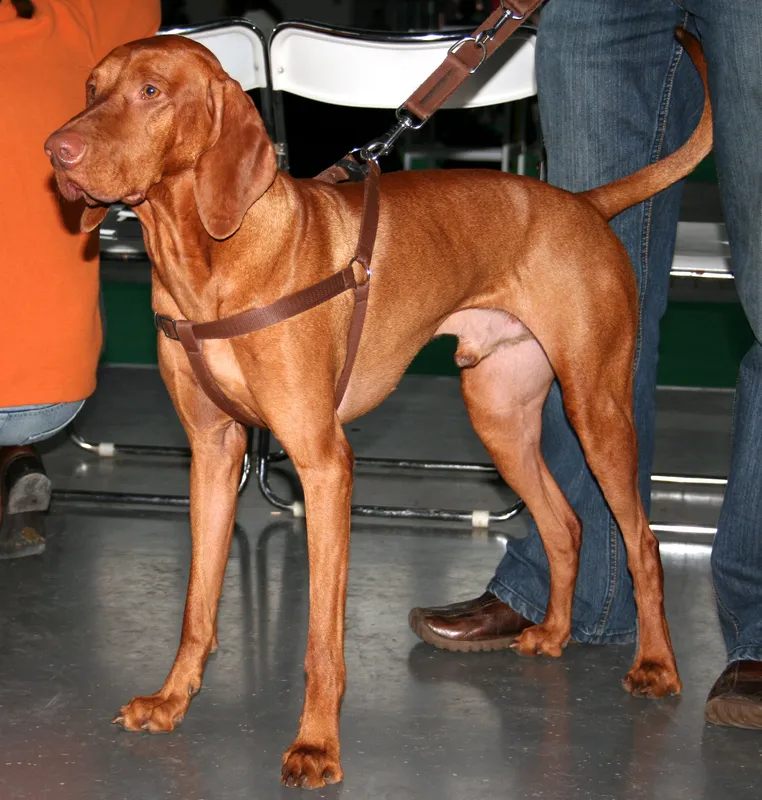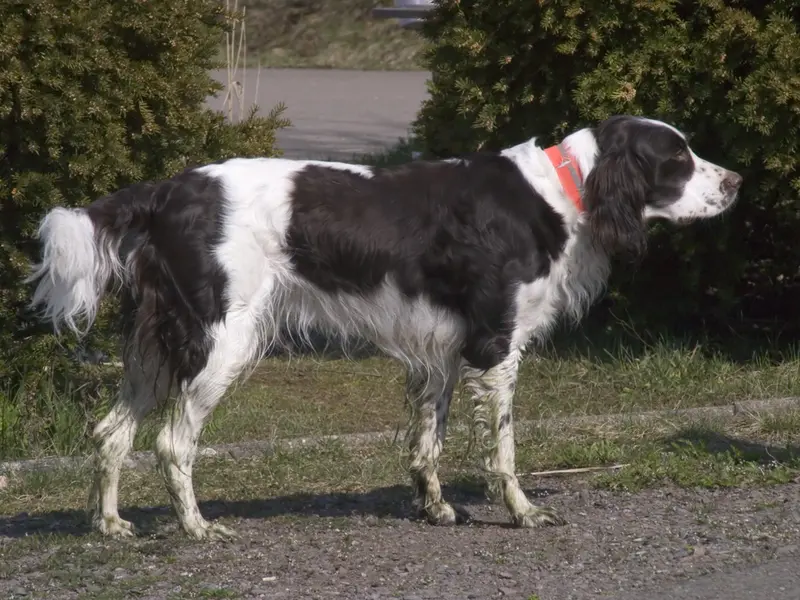Brittany
The Brittany is a medium-sized, energetic sporting dog known for its exceptional hunting abilities and affectionate nature. With a striking coat and a friendly demeanor, they make excellent companions for active families.
Overview
🐕Breed Overview
✨Key Traits
💡What Makes Brittany Special
The Brittany stands out for its versatility as both a hunting dog and a family companion. Its keen sense of smell and strong retrieving instincts make it an exceptional bird dog, capable of working in various terrains.
The breed's compact size and agility allow it to navigate dense cover with ease, while its affectionate nature makes it a beloved family member. Brittanys are also known for their intelligence and eagerness to learn, excelling in obedience and agility training.
Their playful demeanor and love for outdoor activities make them ideal companions for active individuals or families who enjoy spending time outdoors. Additionally, their relatively low grooming needs and friendly disposition further enhance their appeal as family pets.
The Brittany, a medium-sized sporting dog originating from France, is known for its exceptional hunting abilities and affectionate nature. 5 inches and a weight of 30 to 40 pounds, this breed is compact yet agile, making it an ideal companion for active families and hunters alike. Historically bred for pointing and retrieving game, the Brittany has evolved into a versatile dog that excels in various dog sports, including agility and obedience.
Their striking coat can be orange and white, liver and white, or tricolored, with a dense, flat, or wavy texture that requires minimal grooming. Brittanys are highly energetic and require at least 1 to 2 hours of exercise daily, making them best suited for owners who can provide ample physical activity. Their friendly and affectionate demeanor makes them excellent family pets, particularly for families with children.
However, their strong hunting instincts mean they may not be the best fit for homes with small pets. With a lifespan of 14 to 15 years, Brittanys are generally healthy but can be prone to certain hereditary conditions, such as hip dysplasia and epilepsy. Overall, the Brittany is a lively, intelligent, and personable breed that thrives in an active environment, making them a beloved choice for those seeking a loyal and engaging companion.
🎉Fun Facts
Brittanys can smell a group of birds from 75 yards away!
Brittanys excel in various dog sports, including agility and obedience competitions.
They are one of the few breeds that are born naturally bob-tailed.
Breed Characteristics
Family & Friends
Good Behavior
Get Up & Go
Household Harmony
Temperament & Personality
✨Key Traits
🐕Core Temperament
The Brittany is characterized by its alert and curious temperament. They are quick learners, eager to please their owners, and thrive on positive reinforcement during training.
Their independent nature allows them to work well in the field, but they are also affectionate and enjoy being part of family activities. Brittanys are generally friendly and sociable, making them good companions for children and other pets, although supervision is recommended due to their strong prey drive.
They are energetic and require regular exercise to prevent boredom and potential behavioral issues. Overall, the Brittany's temperament is a blend of intelligence, playfulness, and loyalty, making them a well-rounded breed for active families.
💫Personality Profile
Brittanys are known for their lively and affectionate nature. They thrive on human interaction and are particularly good with children, making them excellent family pets. Their energetic disposition means they require regular exercise and mental stimulation to keep them happy.
Brittanys are friendly and eager to please, which makes training relatively easy. However, they can be sensitive to harsh corrections, so positive reinforcement is the best approach. With proper socialization, they generally get along well with other dogs, although their strong prey drive may make them less suitable for homes with small pets.
Overall, Brittanys are intelligent, playful, and devoted companions that bring joy to active households.
🔊Vocal Tendencies
Brittanys are generally moderate barkers. They may bark to alert their owners of strangers or when they are excited, but they are not known to be excessive barkers.
Their vocalizations can vary depending on their mood and the situation, with playful barks during playtime and alert barks when they sense something unusual. Socialization and training can help manage their barking tendencies, ensuring they are well-behaved in various environments.
Overall, while they may bark occasionally, they are not typically known for being overly noisy dogs.
Affection & Social Traits
Energy & Activity
Communication Style
Care Requirements
🏃♂️Exercise Requirements
Daily Exercise
The Brittany is a highly energetic breed that requires a significant amount of exercise to maintain its physical and mental well-being. Ideally, an adult Brittany should engage in at least 1 to 2 hours of vigorous exercise each day.
This can include activities such as running, hiking, playing fetch, or participating in dog sports like agility and obedience training. Puppies and younger Brittanys may need shorter, more frequent exercise sessions to avoid overexertion, while senior dogs may benefit from moderate exercise tailored to their individual health needs.
Regular exercise not only helps manage their weight but also reduces the likelihood of behavioral issues stemming from pent-up energy. Insufficient exercise can lead to destructive behaviors, anxiety, and increased hyperactivity, making it crucial for owners to provide ample physical activity.
Preferred Activities
🏠Living & Adaptability
Space Requirements
Brittanys thrive in environments that offer ample space to run and play. While they can adapt to apartment living, it is essential that owners are committed to providing sufficient daily exercise and mental stimulation.
Ideally, a home with a large, fenced yard is best suited for this breed, allowing them to explore and engage in active play. In rural settings, Brittanys can enjoy the freedom of open spaces, which aligns with their natural instincts as hunting dogs.
Owners in smaller living situations should ensure they have access to parks or open areas for regular exercise. Lack of adequate space can lead to boredom and behavioral issues, so it's important to consider the breed's energetic nature when determining living arrangements.
Climate Preference
🍲Feeding Guide
Schedule
Food Types
Portion Size
Special Nutritional Needs
Brittanys do not have specific dietary restrictions, but it is essential to provide a balanced diet rich in protein to support their active lifestyle. Owners should monitor for any food sensitivities and adjust their diet accordingly. Regular veterinary check-ups can help identify any nutritional deficiencies or health concerns.
✨Grooming Requirements
Grooming Overview
The Brittany has a short, feathered coat that requires minimal grooming. Regular brushing once or twice a week is sufficient to remove loose hair and debris.
Bathing should be done as needed, particularly after outdoor activities. Special attention should be given to their ears, as the floppy structure can trap moisture and debris, leading to infections.
Cleaning the ears regularly with a vet-recommended solution is essential for maintaining ear health. Overall, the Brittany's grooming needs are low, making them an excellent choice for owners seeking a low-maintenance breed.
Care Schedule
Brush once or twice a week; bathe as needed; clean ears regularly.
Health Profile
⚕️Health Care
Regular health care is essential for maintaining the Brittany's lifespan. Routine veterinary check-ups, vaccinations, and preventive treatments can help catch potential health issues early.
Owners should also prioritize dental care, as dental disease can affect overall health. Providing a balanced diet, regular exercise, and mental stimulation will contribute to the dog's well-being throughout its life.
Early detection of health issues through regular veterinary visits can significantly impact the quality and length of a Brittany's life.
Health Issues Overview
⏳Average Lifespan
Genetic Factors
Genetics play a significant role in the Brittany's lifespan, with hereditary health issues such as hip dysplasia and epilepsy being more prevalent in certain bloodlines. Responsible breeding practices that prioritize genetic diversity can help reduce the incidence of these conditions.
Potential owners should seek breeders who conduct health testing and provide transparency about the lineage of their puppies. By choosing a reputable breeder and being aware of the breed's genetic predispositions, owners can make informed decisions that contribute to the longevity and health of their Brittany.
Living Conditions
Brittanys thrive in environments that provide ample space for exercise and play. A home with a large, fenced yard is ideal, as it allows them to run freely and engage in activities that stimulate their hunting instincts.
Additionally, access to parks or open areas for regular exercise is crucial. Social interactions with other dogs and people also contribute positively to their lifespan, as they are social animals that benefit from companionship.
Owners should ensure that their Brittanys are not left alone for extended periods, as this can lead to anxiety and behavioral issues. Overall, a stimulating and active environment is key to promoting a long and healthy life for this breed.
🏥Common Health Issues
Hip Dysplasia
Warning Signs
🔬Diagnosis
X-ray examination by a veterinarian.
💊Treatment
Surgical options may be considered in severe cases; consult a veterinarian for personalized treatment plans.
📝Management Tips
Maintain a healthy weight, provide joint supplements, and engage in low-impact exercise to reduce strain on joints.
Epilepsy
Warning Signs
🔬Diagnosis
Neurological examination and possibly an EEG.
💊Treatment
Anticonvulsant medications may be prescribed to manage seizures.
📝Management Tips
Regular veterinary check-ups, medication as prescribed, and keeping a diary of seizures to track frequency and triggers.
🛡️Preventive Care
🔬Hip Evaluation
Hip Evaluation assesses the hip joints for dysplasia and other abnormalities, which can affect mobility and quality of life.
📅 Recommended annually for adults; puppies should be evaluated before breeding.
🔬Thyroid Test
Thyroid testing checks for hypothyroidism, which can lead to weight gain and lethargy if untreated.
📅 Recommended annually for adults; puppies should be screened before breeding.
🔬Eye Examination
Eye examinations can detect hereditary eye conditions that may affect vision and overall health.
📅 Recommended every 1-2 years, especially for breeding dogs.
Training
🧠Intelligence & Trainability
💪Work Drive
Brittanys have a strong work drive, stemming from their history as hunting dogs. They thrive when given tasks to complete, whether it's retrieving a thrown object, participating in agility courses, or engaging in scent work.
Mental stimulation is just as important as physical exercise for this breed. Activities that challenge their problem-solving abilities, such as puzzle toys or obedience training, can help keep them mentally engaged.
Without sufficient mental and physical stimulation, Brittanys may become bored and exhibit undesirable behaviors, making it essential for owners to provide a variety of activities to fulfill their work drive.
⚠️Training Considerations
Brittanys are generally eager to please and responsive to training, but they can exhibit behavioral challenges if not properly socialized or exercised. Common issues include hyperactivity, destructiveness, and shyness if they are not exposed to various environments and experiences from a young age.
To overcome these challenges, owners should focus on consistent training, positive reinforcement, and regular socialization with other dogs and people. Engaging in obedience training and providing mental stimulation through puzzle toys or interactive games can help channel their energy positively.
Additionally, establishing a routine and setting clear boundaries will aid in managing their behavior effectively.
📝Training Tips
Training a Brittany can be a rewarding experience, as they are intelligent and eager to learn. Positive reinforcement methods, such as treats and praise, work best for this breed. Start training early, focusing on basic commands and gradually introducing more complex tasks.
Consistency is key; use the same commands and cues to avoid confusion. Incorporating play into training sessions can keep them engaged and motivated. Socialization is crucial, so expose your Brittany to different environments, people, and other animals to foster a well-rounded temperament.
Regular training sessions, combined with ample exercise, will help maintain their focus and reduce any potential behavioral issues.
History & Heritage
📜Origin Story
The Brittany breed emerged in the region of Brittany, France, during the 17th to 19th centuries. French sportsmen sought to create a small, agile hunting dog capable of pointing and retrieving game.
This led to the crossing of local spaniels with English setters, resulting in a breed that was not only adept at hunting but also compact and easy to handle. The first written record of the Brittany dates back to 1850, when Reverend Davies described hunting with small bobtailed dogs.
The breed gained recognition at the Paris dog show in 1900 and was officially registered in France in 1907. The Brittany made its way to the United States in the early 20th century, quickly becoming popular among hunters and dog enthusiasts alike.
⏳Development History
The Brittany's development can be traced back to the 17th century, with early depictions of similar dogs in tapestries and paintings. The breed is believed to have originated from crosses between native Brittany spaniels and English setters, resulting in a dog that excels in both pointing and retrieving.
The first official recognition of the Brittany as a distinct breed occurred in 1907, with the establishment of breed standards. Originally known as the Brittany Spaniel, the breed's name was simplified in 1982 to reflect its hunting style, which aligns more closely with that of a pointer than a spaniel.
Over the years, the Brittany has gained popularity in the United States, particularly in field trials, where its exceptional hunting abilities have been showcased.
🛡️Purpose & Historical Role
Historically, the Brittany was bred as a versatile hunting dog, primarily for pointing and retrieving game birds. Its compact size and agility made it an ideal companion for hunters, allowing it to navigate various terrains with ease.
The breed's ability to work closely with its handler and its strong nose contributed to its effectiveness in the field. Over time, the Brittany has also found a place as a beloved family pet, known for its affectionate nature and playful demeanor.
Today, the Brittany continues to excel in hunting, field trials, and various dog sports, showcasing its adaptability and intelligence.
🏺Cultural Significance
The Brittany breed has deep roots in French hunting culture, particularly in the Brittany region of France, where it was developed for bird hunting. Its historical significance is reflected in its role as a versatile hunting companion, prized for its ability to point and retrieve game.
The breed's popularity has transcended borders, becoming a beloved choice for hunters and families alike. In popular culture, the Brittany has been featured in various media, showcasing its intelligence and affectionate nature, further solidifying its status as a cherished companion dog.
The breed's evolution from a hunting dog to a family pet highlights its adaptability and enduring appeal across generations.
Conservation Status
This breed is well-established with healthy population numbers.









